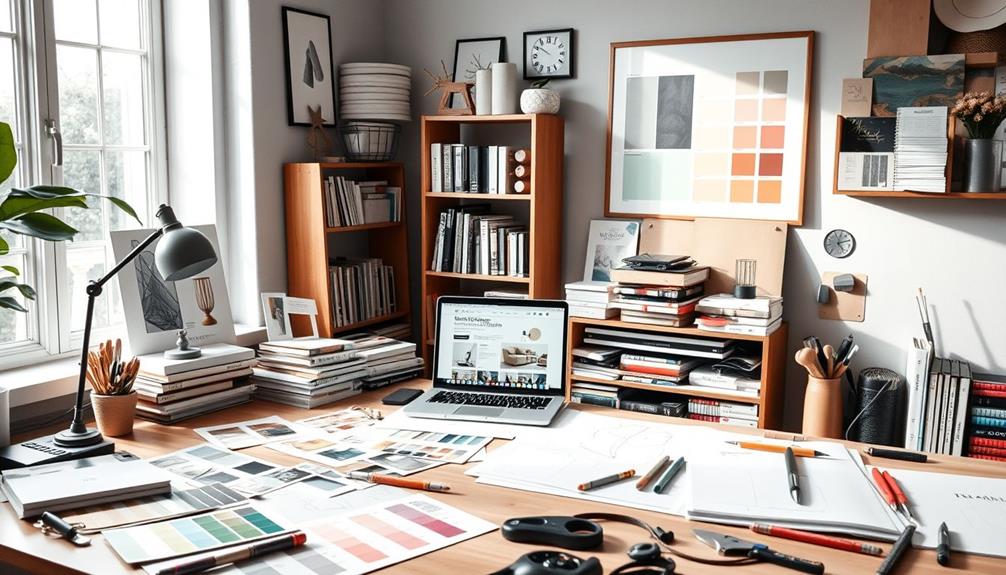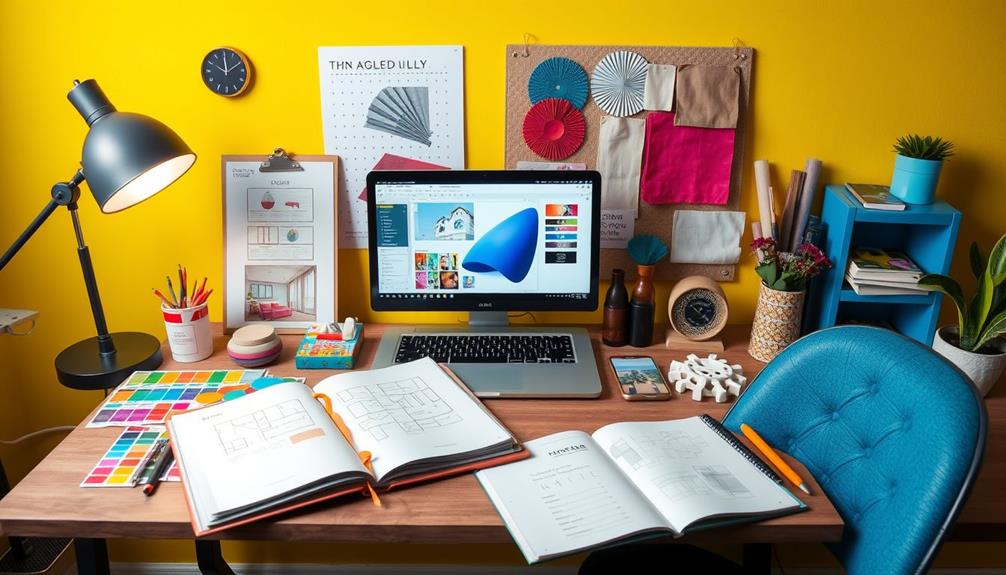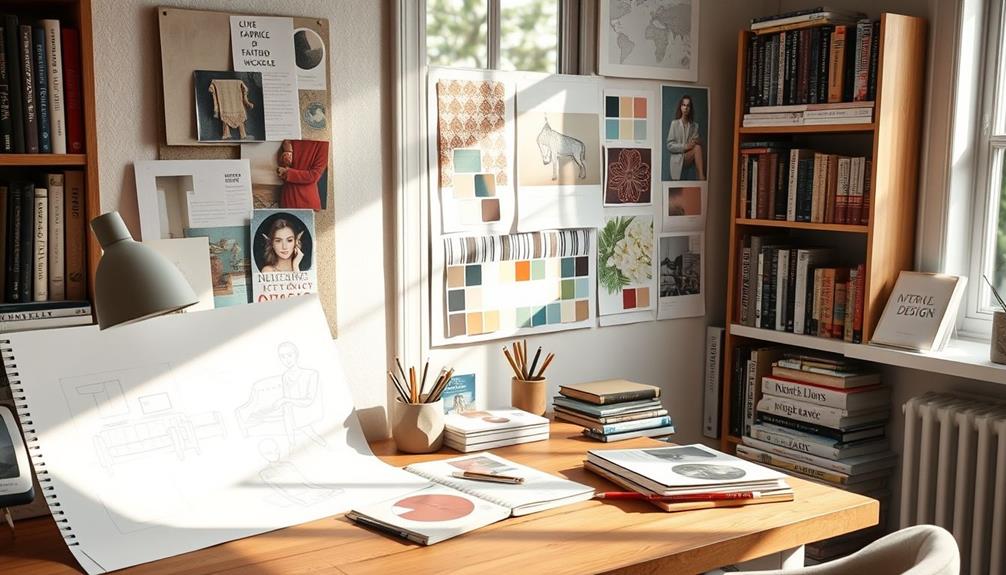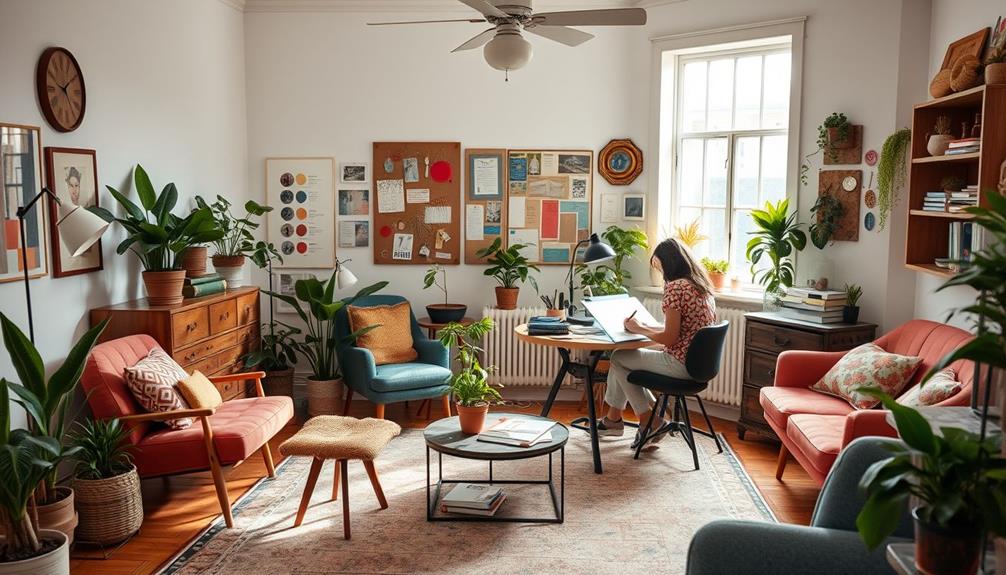To practice interior design effectively, you should assess your skills and interests first. Identify whether you're drawn to residential or commercial spaces and set clear career goals. Pursue an accredited educational pathway, either a Bachelor's or an Associate's degree, and complete hands-on internships. Don't forget to master design software like AutoCAD and SketchUp. Getting certified through the NCIDQ exam is essential for professional recognition, especially in states with specific licensing requirements. Building a strong professional network can provide opportunities and insights into current trends. There's always more to explore in this dynamic field, so keep your curiosity alive.
Key Takeaways
- Assess your skills and interests to determine your focus in residential or commercial interior design.
- Pursue an accredited degree in interior design, aiming for hands-on experience through internships.
- Obtain NCIDQ certification to enhance your professional credibility and meet state licensing requirements.
- Master essential design software like AutoCAD and Revit, and develop strong communication skills for client interactions.
- Build a professional network by joining organizations like ASID, attending industry events, and engaging in mentorship programs.
Assessing Your Skills and Interests

Before diving into the world of interior design, it's vital to assess your skills and interests. Start by distinguishing between your appreciation for aesthetics and functionality. This understanding will guide your path in this field. Once you’ve established your strengths and preferences, seek out tips for interior design from experienced professionals or reputable sources. Learning from others’ experiences can provide valuable insights and help you develop your own unique style. Additionally, consider seeking out internships or volunteer opportunities to gain hands-on experience and further hone your skills.
Consider what design areas excite you most—are you drawn to residential spaces or commercial environments? Your personal preferences can greatly influence your career trajectory. Additionally, aligning your style with trends like cottagecore home office inspiration may enhance your design approach.
Next, set both short- and long-term career goals. This clarity will shape your educational and professional choices, ensuring you stay focused on your desired path. Engage in self-assessment activities, like creating mood boards or designing hypothetical spaces, to explore your design style and preferences. These exercises not only clarify your interests but also enhance your personal design skills.
Don't forget to seek feedback from peers or mentors. Their insights can reveal your strengths and areas for improvement, which are essential for skill development.
Educational Pathways and Options

When you're considering a career in interior design, it's important to explore the various degree options available, like a Bachelor's or Associate's degree.
Accreditation plays a key role in choosing the right program, as it can influence your job prospects after graduation.
Plus, with online learning opportunities on the rise, you can find flexible ways to gain the education you need.
Degree Options Available
If you're considering a career in interior design, exploring your degree options is an essential first step. You can pursue a Bachelor's degree in interior design, which typically requires four years of study and covers crucial topics like color theory, art history, and design software.
Alternatively, an Associate's degree offers a quicker two-year path, though it may limit your job prospects.
When selecting a program, look for accredited degree programs, as accreditation by the Council for Interior Design Accreditation (CIDA) indicates quality and can positively impact job placement rates. Many programs also include hands-on experiences, such as internships, which provide practical skills that enhance your employability before graduation.
Once you've earned your degree, consider certification through the NCIDQ exam, often required for professional recognition in many states. To be eligible, you'll need a degree and specific work experience hours.
Additionally, continuous education and further certifications—like the LEED Green Associate for sustainable design—can improve your job prospects and showcase your commitment to industry trends.
Accreditation Importance Explained
Accreditation plays an important role in shaping your educational journey in interior design. When you choose a program accredited by the Council for Interior Design Accreditation (CIDA), you guarantee that your studies meet high educational standards crucial for professional practice. This is particularly important for eligibility for certification exams like the NCIDQ, which many employers prefer.
Engaging in breathtaking destinations for inspiration can also enhance your design perspective, allowing you to incorporate unique cultural elements into your work.
Typically, a Bachelor's degree in interior design requires four years of study, while an Associate's degree offers a quicker, two-year path. Graduates from accredited programs often enjoy better job placement rates, making it essential to select a reputable institution.
While non-accredited programs may still allow you to sit for certification exams, attending an accredited program greatly enhances your credibility and professional recognition in the industry.
Moreover, continuing education is important for maintaining your certification and staying updated with industry trends and practices. Engaging in accredited continuing education units (CEUs) not only fulfills these requirements but also keeps your skills sharp and relevant.
Online Learning Opportunities
Online learning opportunities have revolutionized the way aspiring interior designers can pursue their education. With accredited programs available from institutions like the University of Cincinnati and Drexel University, you can earn an interior design degree or certificate that's recognized in the industry.
Many reputable online platforms offer specialized online courses covering essential topics such as color theory, space planning, and CAD software, allowing you to build your foundational knowledge at your own pace.
These online courses often provide continuing education units (CEUs), which are vital for maintaining your certifications and staying updated with the latest trends in interior design. Additionally, you can supplement your formal education with courses focused on sustainable design, enhancing your skill set and marketability in a growing field.
Engaging in virtual workshops and webinars hosted by professional organizations like ASID and IIDA not only enriches your learning experience but also provides valuable networking opportunities. Connecting with other professionals in the field can lead to collaborations and job opportunities.
Certification and Licensing Requirements

To succeed in interior design, you'll need to navigate certification and licensing requirements.
First, passing the NCIDQ exam is essential for gaining professional recognition, and you should be aware that some states also require specific licenses.
Understanding these regulations will help you guarantee you meet all necessary criteria to practice legally and effectively.
Certification Exam Process
Becoming a certified interior designer involves guiding through a structured exam process that's vital for establishing your professional credibility. To qualify for the NCIDQ exam, you'll need to complete a formal education program accredited by the Council for Interior Design Accreditation (CIDA) and gain at least two years of professional experience in the field.
The NCIDQ exam is divided into three parts: IDFX (Interior Design Fundamentals), IDPX (Interior Design Professional), and PRAC (Practicum). Each section assesses different aspects of your design knowledge and practical application skills.
Many states require you to pass the NCIDQ exam as part of their licensure process, although certification requirements can vary, so it's important to verify your specific state's regulations. Achieving certification through the NCIDQ not only enhances your credibility but is also recognized in most states.
To maintain your certification, you may need to engage in ongoing education to keep up with the latest industry standards.
State Licensing Regulations
Maneuvering through state licensing regulations is crucial for aspiring interior designers, as these rules can greatly affect your career opportunities. Many states require you to obtain licensure for commercial projects, which typically involves passing the NCIDQ exam. To be eligible for this exam, you need a degree in interior design or architecture and at least two years of professional experience under a licensed designer.
The NCIDQ exam consists of three parts: IDFX (Fundamentals), IDPX (Professional), and PRAC (Practicum). This extensive assessment evaluates your knowledge of design principles, ethics, and practical application.
States like Nevada, Louisiana, D.C., and Puerto Rico have mandatory registration requirements for interior designers, while others mightn't enforce licensing at all.
Obtaining certification through the NCIDQ or similar exams not only boosts your credibility but may also be a prerequisite for employment or contracting work in certain regions or with specific clients.
Essential Skills and Software

A solid foundation in essential skills and software is key to thriving in interior design. Mastering design software like AutoCAD, SketchUp, and Revit will help you create detailed floor plans and 3D models, enhancing your visualization capabilities and project execution.
Here are some critical skills you'll need to focus on:
- Communication Skills: Effectively articulating your design concepts guarantees you understand client needs, impacting project success.
- Time Management: Balancing multiple projects and meeting deadlines is crucial in a fast-paced design environment.
- Project Management: Utilizing project management tools enables you to streamline workflows, manage tasks, and stay organized.
- Continuous Learning: Staying updated on new design software and industry technologies, including AI tools, will give you a competitive edge.
Building a Professional Network

Building a professional network is essential for your success in interior design. By joining professional organizations like the American Society of Interior Designers (ASID) or the International Interior Design Association (IIDA), you can access valuable networking opportunities and resources.
Attend industry events, trade shows, and design exhibitions to interact directly with established professionals and potential clients, enhancing your professional visibility.
Engaging in mentorship programs can also be a game-changer. These programs facilitate knowledge sharing and career guidance, connecting you with experienced designers who can offer insights and valuable opportunities.
Don't underestimate the power of online platforms like LinkedIn, which can help you connect with peers, showcase your work, and stay updated on job openings.
Additionally, participating in local community events and design workshops allows you to foster connections with other creatives and potential clients.
These interactions not only expand your professional network but also deepen your understanding of building codes and design trends.
Staying Current With Industry Trends

Staying ahead in the interior design field requires you to be proactive about industry trends and innovations.
To keep your skills sharp and your designs fresh, it's essential to engage with various resources and communities. Here are some effective ways to stay current:
- Follow industry publications: Regularly read blogs and websites that cover emerging trends and innovations.
- Attend design trade shows: Events like the Kitchen & Bath Industry Show (KBIS) and the International Contemporary Furniture Fair (ICFF) allow you to see new products and network with other professionals.
- Participate in webinars: Enroll in online courses focusing on current trends, sustainability, and technology integration to enhance your knowledge.
- Join professional organizations: Becoming a member of groups like the American Society of Interior Designers (ASID) offers access to valuable resources and networking opportunities.
Conclusion
In the world of interior design, your journey is just beginning. By evaluating your skills, pursuing education, and connecting with others in the field, you'll pave your path to success. Don't forget to stay updated on industry trends and hone your essential skills and software knowledge. After all, who wouldn't want to create spaces that inspire and delight? Embrace your passion for design, and watch your dreams transform into reality!









